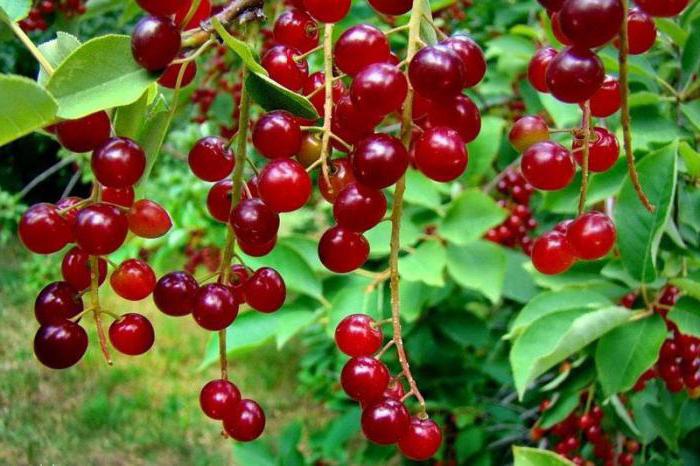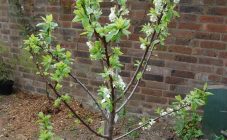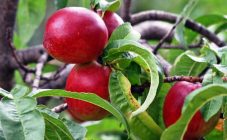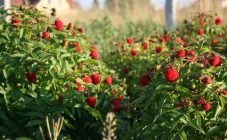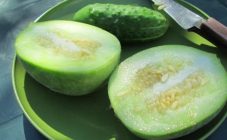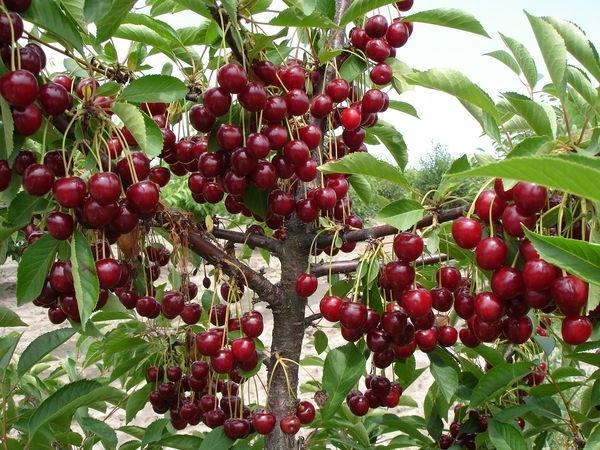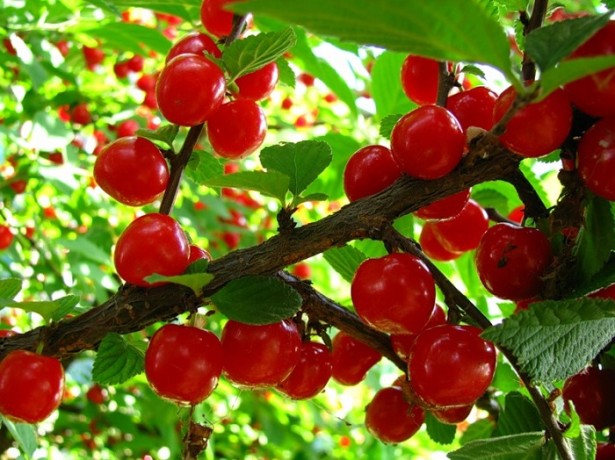Content:
Today there are several known hybrids of bird cherry with different types of fruit trees. Not all of them are successful. A hybrid of cherry and bird cherry deserves attention. Positive results were not obtained immediately, but in the end it was possible to achieve good taste.
Cerapadus and Padocerus
Quite interesting names of hybrids are explained by the peculiarities of their crossing. Cerapadus is the name of a hybrid of cherry and bird cherry, in which the maternal properties are taken from the cherry, and the paternal ones from the bird cherry. This type turned out to be more successful and is quite common in domestic private gardens. However, it is also important to know the name of a cherry crossed with a bird cherry by pollination of the mother cherry flowers with cherry pollen - this is a padocerus. The usefulness of this species lies in the fact that it became the starting material for many varieties of cherries, including such popular ones as Almaz and Kharitonovskaya.
It turned out that not every variety of bird cherry can be crossed with cherry. The Japanese Maaka was the best option. It initially combines the properties of bird cherry and cherry, but its fruits are bitter.
Only after re-crossing the cerapadus with cherries, we managed to get decent varieties: Long-awaited, Novella, Vstrecha, Rusinka. Their clusters contain 3-4 berries, the size and taste of which resemble those of cherry trees. Useful fruits are mainly used for making juices, jams, syrup. The healing properties of the products are explained by the presence of vitamins - A, B (group) and E.
In the breeding direction, cerapaduses are used as a material for grafting cherries, sweet cherries, plums.
Features of modern hybrids
It should be noted that thanks to the efforts of breeders, the appearance of modern cerapadus has also changed. The crown has acquired a density, which is additionally provided by a large number of leaves.
Getting the first grafted crops using cerapadus hybrids led to the following characteristics:
- excellent indicators of winter hardiness;
- resistance to various diseases, including coccomycosis;
- the size of the fruit has become much larger;
- high productivity is observed.
A little later, varieties with racemose inflorescences were bred. The benefits of this species are not too obvious, because they have to interbreed and vaccinate in the same way.
List of varieties
Due to their beneficial qualities, some varieties of hybrids of Cerapadus and especially Padoceruses deserve special attention.
Among the cerapaduses, experts note the following varieties:
- Novella. A tree up to 3 m high with a well-developed root system. Self-pollinating variety, medium early ripening. It has excellent resistance to coccomycosis and tolerates the most severe frosts well. Fruits are black, large.
- Rusinka. The species has a bush-like shape, the height of which can reach 2 m. Maturing later, self-pollinating, resistant to frost and diseases. The berries are small, black. The fruit tastes sweet with sourness.They produce jam with an original flavor.
- In memory of Lewandowski. Shrub cherry. Requires pollination (for neighbors it is best to choose cherry trees of Turgenevka, Ashinskaya, Lyubskaya). It tolerates cold normally and is resistant to infections with coccomycosis. The yield is rather average. The berries taste sweet and sour.
After we started crossing bird cherry and cherry, we got the best varieties of Padoceruses:
- Padocerus-M. The hybrid is basic and laid the foundation for such varieties as Korona, Firebird, Aksamit, Kharitonovskaya. The latter, by the way, deserves special attention. The garden tree grows up to 2-3 m in height. Requires third-party pollinators (Zhukovskaya and Vladimirskaya are great). This cherry has rather large dark red fruits, orange flesh. Gives a rich harvest due to its resistance to various types of diseases.
- Firebird. By correctly pruning, the plant can be shaped like a bush or tree. Dark coral berries are of medium size. The fruit tastes sweet with a tart aftertaste. Productivity is high, but cold resistance is low. More suitable for southern regions.
- Crown. It has a distinctive feature - its fruits are located in a group and have a pleasant taste with a slight sourness. The yield is stable. The plant is often formed in the form of a bush. Differs in high resistance to specific diseases.
- Long-awaited. A variety with a powerful root system. The crown is rounded with moderate density. It is in this species that the fruits most of all taste like cherries. The color of the berries is dark cherry, the flesh is tender and juicy, the skin is dense. The stone is large, well separated from the pulp.
Growing hybrids
Today, hybrids of cherry and bird cherry are rarely found on a personal plot. The main reason is the original taste of the fruit, which not everyone likes. Most often, hybrids are used to plant fruit trees: cherry, sweet cherry, plum.
Landing features
In order not to purchase a fake, namely the desired hybrid, you need to contact specialized stores.
It is best to familiarize yourself with the specifics of this process before planting.
- Landing takes place in April or September. In the autumn, it is better to act early so that the seedling has time to take root before the onset of frost.
- Hybrids are planted in any soil with a neutral environment. The place is chosen well lit, but not in a draft.
- The indentations for planting are prepared in advance, several weeks before the process.
- To ensure a constant yield on the site, it is better to plant 2 - 3 crops. This is due to the fact that hybrids cannot provide a stable annual yield and periodically rest.
- It is necessary to place hybrids on the site at a sufficiently large distance. Otherwise, the powerful root system of different trees will intertwine under the ground and this will not lead to anything good. In one row, seedlings are placed 2.5-3 m apart, and between rows - up to 3.5 m.
Preparing seedlings for planting
For better rooting of seedlings, they must be prepared before planting - they are placed in water a couple of hours before starting.
Next, a mixture is prepared from the following ingredients:
- humus - 2 buckets;
- soil - 1 bucket;
- potash and phosphorus fertilizers - 100 g each
The last ingredient can be replaced with 200 g of nitrophoska.
All components are mixed and poured into the prepared depression with a tubercle. A seedling is placed on top, pressing the soil mixture with the root system. Next, sprinkle with soil to half the level of the hole. They compact it a little and fill it with a bucket of medium temperature water. After the liquid has completely absorbed, the cavity is completely covered with soil. Water and mulch abundantly again.
Care measures
According to gardeners, cerapaduses are not very demanding to care for.All activities are reduced to eliminating weeds around the crop trunk. But, to ensure normal development, it will not hurt to make preventive feeding. This is usually done once every 2-3 years, in early spring. You also need to constantly remove the root growth.
Although bird cherry crossed with cherry is an unpretentious crop, pruning and thinning of the crown must be done systematically. In the early years, the formation of the stamp and crown is carried out. Subsequent measures are sanitary, during which dry, sick, crooked branches are removed. With a high density, the crown is cut open and excess shoots are removed from the aerial part of the bush.
The stamp is formed according to the following parameters:
- height - 0.5 - 0.6 m;
- crown in two, three tiers;
- in each tier, 3-4 main shoots are left.
Ceropadus and Padocerus grow quite quickly and are used by many summer residents to create hedges. Most often it has a decorative function. At the same time, due to the abundant flowering, the culture attracts a large number of bees to the site. This increases the likelihood of pollination and other flowering plants on the site.
Protection against diseases and pests
The degree of resistance of the hybrid species to parasites and diseases is quite high. It is because of this property that they are often used as rootstocks for other fruit trees. In this way, they are trying to protect crops from coccomycosis and other diseases.
Preventive control of diseases and parasites is carried out in early spring before bud break. Hybrids are sprayed with a 2% solution of Bordeaux liquid. Then, during the growing season, the crown and soil under the crop must be treated with biological preparations Planriz, Alirin-B, Boverin, Aktofit. This is where all the measures to protect cerapadus and padocerus from diseases and diseases end.

